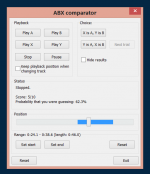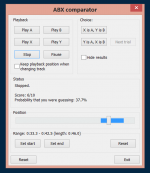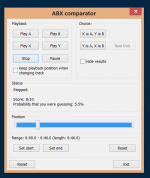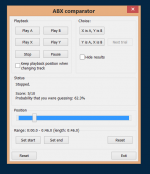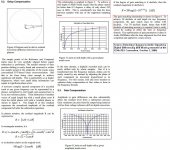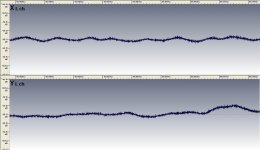I think there were some lucky guesses. The files are just too similar for it to be anything but luck. Of course you won't believe me, but I would bet money on it.
Attached below is the spectrum of the difference between the 2 files. Look at the levels.
Only luck if someone really didnt hear any difference and then guessed.
THx-RNMarsh
We have to measure the harmonic or IM spectrum of the IC loaded and unloaded. I am pretty sure you will find plenty of difference.
Mix is as the term implies, effectively subtracting X from Y. If X were a perfect replica of Y, but only differing in amplitude then the waveform would look the "same". Note the scale on the left, the difference waveform is being shown at x100 zoom, meaning only 40dB down ...
Good work Frank. Now what I'm seeing here is that the 'mix' signal corresponds very roughly to the noise artifacts I'd expect to see on the power supplies, given that we've a classAB opamp driving a heavy load. I say that because there's an apparent 'frequency doubling' effect, pretty much what a classAB output stage imposes on its non-zero impedance supply rails. Depending on the supply decoupling this HF noise could be coupling in via the 0V (if rail caps are decoupling to 0V) or this could be exposing inadequate opamp PSRR.
Perhaps Mooly you could run the test again but with much better supply decoupling? I suggest a dozen or more 10uF SMT ceramic caps between the supply pins of the opamp (not to 0V).
Just wait until you read the editorial in the November Stereophile about listening tests. '-)
Having looked very closely at the two files I can tell you they are almost identical. The differences are:
What is not different, as far as I've been able to tell.
- Gain. A difference of about 0.02dB between the two files, maybe less
- Noise. What remains in the difference is mostly noise. Some hiss and some power mains noise. Pretty much what you would expect. Noise would not be correlated, so would remain as a difference.
Differences are 65 to 70dB down
- Frequency response
- Phase
- Harmonic structure
I think there were some lucky guesses. The files are just too similar for it to be anything but luck. Of course you won't believe me, but I would bet money on it.
Attached below is the spectrum of the difference between the 2 files. Look at the levels.
Thanks very much for the analysis Pano. That's pretty 😎
The only thing I can add is that those differences have to be due solely to removal of the 100 ohm and doing an identical re-run to make the second file. Nothing was moved, nothing else changed. Just hit "play" a second time and restart Audacity.
Why are we discussing the subject here, where it becomes intermingled with all sorts of unrelated conversations, when there is a dedicated thread on the subject (I have posted an analyzis there)?
Only luck if someone really didnt hear any difference and then guessed.
THx-RNMarsh
Since the votes were not really consistent and even contradictory, it indeed looks like some got lucky, some not.
We have to measure the harmonic or IM spectrum of the IC loaded and unloaded. I am pretty sure you will find plenty of difference.
Hey John, your SR1 would be a great instrument for that! Should be an interesting measurement, no?
Jan
Why are we discussing the subject here, where it becomes intermingled with all sorts of unrelated conversations, when there is a dedicated thread on the subject (I have posted an analyzis there)?
Where?
Since the votes were not really consistent and even contradictory, it indeed looks like some got lucky, some not.
I suppose the next thing you're going to tell me is that Washington correctly calling the coin toss last night for overtime was a matter of luck rather than the Redskins player being skilled at picking heads or tails. You rationalists are so boringly predictable!
I know. Pains me more than you
I didn't know that you were a Cowboys fan. That's a pity.
Attached below is the spectrum of the difference between the 2 files. Look at the levels.
Note the scale on the left, the difference waveform is being shown at x100 zoom, meaning only 40dB down ...
When I see some amount of such low subsonic freq in a spectrum from a file that is the difference btn two digital recordings, my mind goes first to misaligned files.
After Pano’s and Frank’s posts, I looked deeper into the X and Y files as uploaded by Mooly.
They are not that aligned for to do this nitpicking. They need some trimming for better time alignment.
On Y file, music is time shifted 8.729ms compared to X file.
Thus the first 8.729ms have to be trimmed off from file Y. This way the two files will be time aligned .
Then file X has to be trimmed off by 8.729ms at the end, for the two files to be of equall length (45s991.271ms)
Alas, time alignment to 21us (due to original sampling rate of 48k)is not good enough. See attachment 1
Mooly’s files may be OK for listening tests but not for applying on them such elaborate differential techniques.
The only thing I can add is that those differences have to be due solely to removal of the 100 ohm and doing an identical re-run to make the second file. Nothing was moved, nothing else changed. Just hit "play" a second time and restart Audacity.
Next think to consider after proper alignment of files is power supply LF noise. This can not be synchronized btn the two recordings by any means and so phase & amplitude differences of psu noise will show up in the difference file. I have attached such a noise fingerprint seen at the end of the two synchronized files.
🙂
George
Attachments
Last edited:
What ? there were two questions implied.Since the votes were not really consistent
At the first one: Witch file is the "unloaded", if I'm not mistaken, all players witch answered this question were correct: "Y".
Some preferred X, some Y. Tastes and colors. And quality of the source.
We can conclude: There is an audible difference. Correlated by measurements (that there is a difference). And the knowledge of the players were good enough to identify the source of the differences. I call this damn consistent !
And, yes:
Oh, the power of the human ear to hear differences where conventional test equipment fails! '-)
Last edited:
We can conclude: There is an audible difference.
No we can't. There may indeed be one, but there's no significant evidence that there is, nor any evidence that if a difference can be heard, it was due to the loading. Basic statistics.
Mooly was the only one to run a statistically significant number of trials.
George, the the waveforms as I presented them were aligned to a single sample accuracy. And, within that they are aligned to at least a 20x greater accuracy - I filtered out all below 10kHz, selected the area with the highest average amplitude, and zoomed in - without getting anal about it, the time alignment is easily within 1us. The "new" frequencies within the difference file are what's significant, as abraxalito points out.They are not that aligned for to do this nitpicking. They need some trimming for better time alignment.
On Y file, music is time shifted 8.729ms compared to X file.
Thus the first 8.729ms have to be trimmed off from file Y. This way the two files will be time aligned .
Then file X has to be trimmed off by 8.729ms at the end, for the two files to be of equall length (45s991.271ms)
Alas, time alignment to 21us (due to original sampling rate of 48k)is not good enough. See attachment 1
Mooly’s files may be OK for listening tests but not for applying on them such elaborate differential techniques.
The differences could be there for all sorts of reasons - but the point is, that they are there. The waveforms are different, beginning and end of story - and, those differences may, or may not be audible.Next think to consider after proper alignment of files is power supply LF noise. This can not be synchronized btn the two recordings by any means and so phase & amplitude differences of psu noise will show up in the difference file. I have attached such a noise fingerprint seen at the end of the two synchronized files.
🙂
George
Last edited:
- Status
- Not open for further replies.
- Home
- Member Areas
- The Lounge
- John Curl's Blowtorch preamplifier part II
